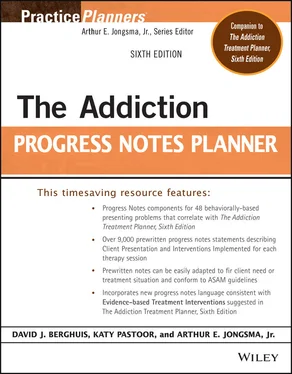The Addiction Progress Notes Planner
Здесь есть возможность читать онлайн «The Addiction Progress Notes Planner» — ознакомительный отрывок электронной книги совершенно бесплатно, а после прочтения отрывка купить полную версию. В некоторых случаях можно слушать аудио, скачать через торрент в формате fb2 и присутствует краткое содержание. Жанр: unrecognised, на английском языке. Описание произведения, (предисловие) а так же отзывы посетителей доступны на портале библиотеки ЛибКат.
- Название:The Addiction Progress Notes Planner
- Автор:
- Жанр:
- Год:неизвестен
- ISBN:нет данных
- Рейтинг книги:5 / 5. Голосов: 1
-
Избранное:Добавить в избранное
- Отзывы:
-
Ваша оценка:
- 100
- 1
- 2
- 3
- 4
- 5
The Addiction Progress Notes Planner: краткое содержание, описание и аннотация
Предлагаем к чтению аннотацию, описание, краткое содержание или предисловие (зависит от того, что написал сам автор книги «The Addiction Progress Notes Planner»). Если вы не нашли необходимую информацию о книге — напишите в комментариях, мы постараемся отыскать её.
The Addiction Progress Notes Planner, Sixth Edition
Addictions Treatment Planner, Sixth Edition
Addiction Treatment Planner, Sixth Edition
The Addiction Progress Notes Planner
The Addiction Progress Notes Planner — читать онлайн ознакомительный отрывок
Ниже представлен текст книги, разбитый по страницам. Система сохранения места последней прочитанной страницы, позволяет с удобством читать онлайн бесплатно книгу «The Addiction Progress Notes Planner», без необходимости каждый раз заново искать на чём Вы остановились. Поставьте закладку, и сможете в любой момент перейти на страницу, на которой закончили чтение.
Интервал:
Закладка:
28 Provide Rationale for Treatment (28)The client was provided with the rationale for treatment involving ongoing medication and psychosocial treatment.The focus of treatment was emphasized, including recognizing, managing, and reducing biological and psychological vulnerabilities that could precipitate relapse.A discussion was held about the rationale for treatment.The client was reinforced for understanding of the appropriate rationale for treatment.The client was redirected when displaying a poor understanding of the rationale for treatment.
29 Enhance Motivation for Medication Adherence (29)Motivational interviewing techniques were used to help the client identify and increase motivation for medication adherence.The client was asked about satisfaction with the current level of medication adherence and mood stability.The client was assisted in identifying the benefits of changing their approach to the medication.The client was assisted in assessing optimism for making changes in the medication adherence pattern.The client was assisted in developing specific tactics for medication adherence.
30 Educate About Medication Adherence (30)The client was educated about the importance of medication adherence.The client was taught about the risk for relapse that occurs when medication is discontinued.The client was asked to make a commitment to prescription adherence.The client was reinforced for understanding and commitment to prescription adherence.The client was redirected when displaying poor understanding or commitment to prescription adherence.
31 Assess Prescription Nonadherence Factors (31)Factors that have precipitated the client's prescription nonadherence were assessed.The client was checked for specific thoughts, feelings, and stressors that might contribute to prescription nonadherence.The client was assigned “Why I Dislike Taking My Medication” from the Adult Psychotherapy Homework Planner (Jongsma & Bruce).A plan was developed for recognizing and addressing the factors that have precipitated the client's prescription nonadherence.
32 Coordinate Group Psychoeducational Program (32)The client was admitted to a group psychoeducational program that teaches clients the psychological, biological, and social influences in the development of bipolar disorder.The client's involvement in the group psychoeducational program focused on the biological and psychological treatment of the disorder.The client has followed through on involvement in a group psychoeducational program and key topics were reviewed.The client has not followed through on involvement in a group psychoeducational program and was redirected to do so.
33 Teach Illness Management Skills (33)The client was taught about illness management skills.The client was taught about identifying early warning signs, common triggers, and coping strategies.The client was taught about problem-solving regarding life goals and development of a personal care plan.
34 Use Cognitive Therapy Techniques (34)Cognitive therapy techniques were used to identify, challenge, and change cognitive appraisals that make the client vulnerable to manic or depressive episodes.The client was reinforced for greater insight into their cognitive appraisals.
35 Assign Homework (28)The client was assigned homework exercises in which they do behavioral experiments to test biased versus alternative predictions.The client was assigned “Journal and Replace Self-Defeating Thoughts” in the Adult Psychotherapy Homework Planner (Jongsma & Bruce).The client was assisted in reviewing their insight regarding biased versus alternative predictions and successes were reinforced.The client was provided with corrective feedback toward improvement of understanding of biased or alternative predictions.
36 Teach Coping and Relapse Prevention Skills (36)The client was taught coping and relapse prevention skills via cognitive-behavioral techniques.The client was taught about delaying impulsive actions, structuring and scheduling daily activities, keeping a regular sleep routine, avoiding unrealistic goals striving, and using relaxation procedures.The client was taught about identifying and avoiding episode triggers.The client was assigned “Keeping a Daily Rhythm” in the Adult Psychotherapy Homework Planner (Jongsma & Bruce).The client was reinforced for understanding of taught skills.The client did not understand the provided skills and additional information was provided.
37 Conduct Family-Focused Treatment (37)The client and significant others were included in the treatment model.Family-focused treatment was used with the client and significant others as indicated in Bipolar Disorder: A Family-Focused Treatment Approach (Miklowitz & Goldstein).As family members were not available to participate in therapy, the family-focused treatment model was adapted to individual therapy.
38 Assess Family Communication (38)Objective instruments were used to assess the family communication.The level of expressed emotions within the family was specifically assessed.The family was educated about the role of aversive communication (e.g., highly expressed emotion), how it increases risk of relapse, and how change in communication style can reduce that risk.The family displayed a clear understanding of the effects of aversive communication and this was reinforced.The family was provided with feedback about their style of communication.The family has not been involved in the assessment of communication style, and the focus of treatment was diverted to this resistance.
39 Teach Communication Skills (39)Behavioral techniques were used to teach assertive communication skills.Assertive communication skills, such as offering positive feedback, active listening, making positive requests for behavioral change, and giving negative feedback in an honest, respectful manner, were taught to the client and family.Behavioral techniques were used to teach the family healthy communication skills.Education, modeling, role-playing, corrective feedback, and positive reinforcement were used to teach communication skills.The family was taught the HARD acronym: honest, appropriate, respectful, and direct.
40 Address Problem-Solving (40)The client was asked to identify conflicts that can be addressed through using problem-solving techniques.The family members were asked to give input about conflicts that could be addressed using problem-solving techniques.The client and family arrived at a list of conflicts that could be addressed using problem-solving techniques.
41 Teach Problem-Solving Skills (41)Cognitive behavioral techniques, such as education, modeling, role-playing, corrective feedback, and positive reinforcement, were used to teach the client and family problem-solving skills.Specific problem-solving skills were taught to the family, including defining the problem constructively and specifically, brainstorming options, evaluating options, choosing options, implementing a plan, evaluating the results, and reevaluating the plan.The client was assigned “Applying Problem-Solving to Interpersonal Conflict” in the Adult Psychotherapy Homework Planner (Jongsma & Bruce).Family members were asked to use the problem-solving skills in specific situations.The family was reinforced for positive use of problem-solving skills.The family was redirected for failure to properly use problem-solving skills.
42 Assign Problem-Solving Homework (42)The client and family were assigned to use newly learned problem-solving skills and record their use.The client and family were assigned “Plan Before Acting” in the Adult Psychotherapy Homework Planner (Jongsma & Bruce).The client and family were assigned “Problem Solving: An Alternative to Impulsive Action” in the Adult Psychotherapy Homework Planner (Jongsma & Bruce).The results of the family members’ use of problem-solving skills were reviewed within the session.The family members’ appropriate use of problem-solving skills was reinforced.The family members’ obstacles were resolved toward sustained, effective use.
Читать дальшеИнтервал:
Закладка:
Похожие книги на «The Addiction Progress Notes Planner»
Представляем Вашему вниманию похожие книги на «The Addiction Progress Notes Planner» списком для выбора. Мы отобрали схожую по названию и смыслу литературу в надежде предоставить читателям больше вариантов отыскать новые, интересные, ещё непрочитанные произведения.
Обсуждение, отзывы о книге «The Addiction Progress Notes Planner» и просто собственные мнения читателей. Оставьте ваши комментарии, напишите, что Вы думаете о произведении, его смысле или главных героях. Укажите что конкретно понравилось, а что нет, и почему Вы так считаете.












